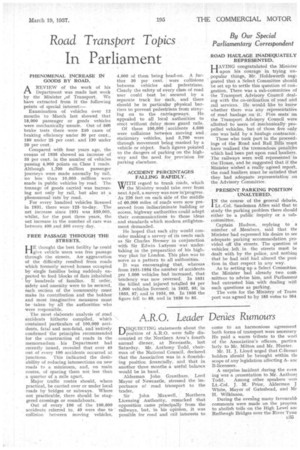Road Transport Topics
Page 85

If you've noticed an error in this article please click here to report it so we can fix it.
In Parliament
By Our Special Parliamentary Correspondent
PHENOMENAL INCREASE IN GOODS BY ROAD.
A REVIEW of the work of his Department was made last week by the Minister .of Transport. We have extracted from it the following points of special interest:—
Examination of vehicles over 12 months to March last showed that 18,000 passenger or goods vehicles were mechanically unsafe. Out of 560 brake tests there • were 240 cases of braking efficiency under 30 per cent., 180 under 25 per cent. and 130 under 20 per cent.
Compared with four years ago, the census of 1935 showed an increase of 35 per cent, in the number of vehicles passing 4,900 points on Class 1 roads. Although 1,700 Million passenger journeys were made annually by rail, no less than 10,000 million were made in public vehicles by road. The tonnage of goods carried was increasing not only by rail, but also at a phenomenal rate by road.
For every hundred vehicles licensed in 1931, there were 125. to-day. The net increase since 1931 was 550,000, whilst, for the past three years, the net increase in the number of cars was between 400 and 500 every day.
FREE PASSAGE THROUGH THE STREETS.
HE thought the best facility he could give vehicle users was free passage through the streets. Are aggravation of the difficulty resulted from roads which formerly served houses occupied by single families being suddenly expected to feed blocks of flats inhabited by hundreds of families. If order, safety and amenity were to be secured, each section of the 'community must make its contribution and the boldest and most imaginative measures must be taken by all the authorities who were responsible.
The most elaborate analysis of road accidents hitherto compiled, which contained particulars of 100,000 accidents, fatal and non-fatal, and -entirely confirmed 'the principles recommended for the construction of roads in the memorandum his Department had recently issued, revealed that over 40 out of every 100 accidents occurred at junctions. This indicated the desirability of reducing intersectiOns on new roads to a minimum, and, on main routes, of spacing them not less than a quarter of a mile apart.
Major traffic routes should, where practical, be carried over or under local roads by bridges or subways. Where not practicable, there should be staggered crossings or roundabouts.
Out of every. 100 of the 100,000 accidents referred to, 40 were due to collision between moving vehicles,
4,000 of them being ead-on. A further 30 per cent, were collisions between vehicles and pedestrians. Clearly the safety of every class of road user could best be secured by a separate track for each, and there should be in particular physical barriers to prevent pedestrians from straying on to the ca4iiageways. He appealed to all loca4l authorities to erect without delay ore guard rails.
Of these 100,000 I accidents 4,600 were collisions betw en moving and stationary vehicles, tnd 3,700 were through movement being masked by a vehicle or object. Such figures pointed to the dangers of parking on the highway and the need for provision for parking elsewhere.
ACCIDENT PERCENTAGES FALLING RAPIDLY.
WITH regard to trunk roads, which YV the Ministry would take over from next April, a survey was now inprogress. As 220 feet on each side of the middle of 60,000 miles of roads were now preserved from indiscriminate building or access, highway authorities could adapt their communications to those ideas and standards which modern enlightenment demanded.
He hoped that each city would consider making a survey of its needs such as Sir Charles Bressey in conjunction with Sir Edwin Lutyens was undertaking in the preparation of his highway plan for London. This plan was to serve as a pattern to all authorities.
It was encouraging that, whereas from 1931-1934 the number of accidents per 1,000 vehicles had increased, that tendency was now reversed. In 1931 the killed and injured totalled 94 per 1,000 vehicles licensed; in 1932, 95; in 1933, 97; and in 1934, 99. In 1935 the figure fell to 88, and in 1936 to 85. ROAD HAULAGE INADEQUATELY REPRESENTED.
HAVING congratulated the Minister upon his courage ii trying unpopular things, Mr. Holdsworth suggested that a Select Committee should be set up to settle this question of congestion. There was a sub-committee of the Transport Advisory Council dealing with the co-ordination of road and rail services. He would. like to know whether there • was any representative of road haulage on•it. Five =eats' on the Transport Advisory Council were allotted to users of -mechanically propelled vehicles, but of those five only one was held by a haulage contractor.
Those who took part in the proceedings of the Road and Rail Bills must have realized the tremendous penalties which had been put upon road hauliers. .The railways were well represented 'in the House, and he suggested that if the Minister wished a really agreed report, the road hauliers must be satisfied that they had adequate representation. on the Advisory Committee.
PRESENT PARKING POSITION UNALTERED.
IN the course of the general debate, I Lt.-Col. Sandeman Allen said that to study the parking problem there should either be a public inquiry or a subcommittee.
Captain Hudson, replying to a number, of Members, said that the Minister had expressed his desire to see adequate parking accommodation provided of the streets. The question oi vehicles left in the streets must be dealt with by the police, and nothirip that he had said had altered the position in that respect in any way.
As to setting up a Select Committee, the Minister had already two committees to advise him, and Parliarneni had entrusted him with dealing witl such questions as parking.
The vote for the Ministry of Trans. port was agreed to by 185 votes to 104.
























































































































































